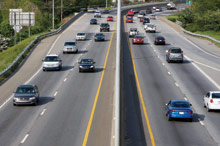High atop Mount Mitchell, an air monitor installed by the state tracks ozone. Oddly enough, it sometimes detects unsafe levels of the pollutant, a respiratory irritant, in the middle of the night—when no cars are passing through, and temperatures have dropped far below the level favorable for ozone formation. Why?

The wind actually carries the midday pollution up from the valleys to the ridgeline where, many hours later, it’s picked up by the monitor.
Air-quality engineers call this kind of displaced pollution “transport.” It’s often cited as a principal reason for Asheville’s subpar air quality: Winds from eastern Tennessee, for example, carry ozone-forming gases and particulate matter to Asheville—a “bowl” nestled in the mountains—and under the right conditions, the smog just lingers. But according to Engineering Supervisor Ashley Featherstone of the Western North Carolina Regional Air Quality Agency, transport from outside sources is only one piece of the puzzle. “Any locally generated pollution exacerbates the problem,” she noted at an April 29 ozone forum hosted by the Land-of-Sky Regional Council. Tailpipe emissions from cars and trucks, she added, are the No. 1 local contributor to the area’s air-quality problems.
Every summer, a combination of higher temperatures, increased demand for electricity and more traffic causes local ozone levels to rise. On bad-air days, hospitals admit more patients suffering from respiratory issues and heart problems. And a recent change in the U.S. Environmental Protection Agency’s ozone standards will probably mean more “yellow” and “orange” ozone days this spring and summer than in previous years, noted EPA staffer Scott Jackson.
The new rule, adopted in March after a review of some 1,700 health studies, establishes a lower threshold for ozone hazard. Although Buncombe County was in compliance with the old standard, the new rule makes the area “very borderline,” said Featherstone. Buncombe County averages about 74 parts per billion, and 75 parts per billion is now considered a violation, she explained. Counties failing to comply with the new standard could lose federal funding for projects such as road construction, and it would be harder to obtain permits for new industrial facilities, according to Paul Muller of the Division of Air Quality. The final word on which areas are in violation won’t come until 2010, however.
Meanwhile, this doesn’t mean that Western North Carolina’s air quality is going downhill. Representatives from both the air agency and Land-of-Sky were quick to point out recent improvements in the region. In 2005, Progress Energy began retrofitting its coal-fired Skyland power plant, drastically reducing the amount of sulfur dioxide spewed into the air. SO2 emissions plummeted from 15,545 tons in 2005 to 528 tons last year. As a result, Buncombe County’s total SO2 emissions dropped 88 percent, according to Featherstone. The technology has also reduced nitrogen-oxide levels, another factor in ozone production.
Leonard Bernstein, who worked on the Intergovernmental Panel on Climate Change and won a share of the Nobel Prize awarded to Al Gore and a host of IPCC scientists, spoke briefly about the bigger picture. Globally, humans are releasing some 40 billion tons of carbon dioxide into the atmosphere each year, he noted, and that number continues to rise. To avoid the catastrophic effects of climate change, “What we must do is eventually bring net emissions of greenhouse gases close to zero,” he said.
Muller of the Division of Air Quality emphasized that carbon dioxide is not a regulated pollutant: Utilities and other industries can emit substantial quantities of the heat-trapping gas with no legal ramifications. The state agency has launched a voluntary program for large polluters to monitor and report their carbon emissions, he noted, and next year this will become mandatory—a potential first step toward carbon regulation. But with no federal limit in place, said Muller, that move is still a long way off.


Before you comment
The comments section is here to provide a platform for civil dialogue on the issues we face together as a local community. Xpress is committed to offering this platform for all voices, but when the tone of the discussion gets nasty or strays off topic, we believe many people choose not to participate. Xpress editors are determined to moderate comments to ensure a constructive interchange is maintained. All comments judged not to be in keeping with the spirit of civil discourse will be removed and repeat violators will be banned. See here for our terms of service. Thank you for being part of this effort to promote respectful discussion.